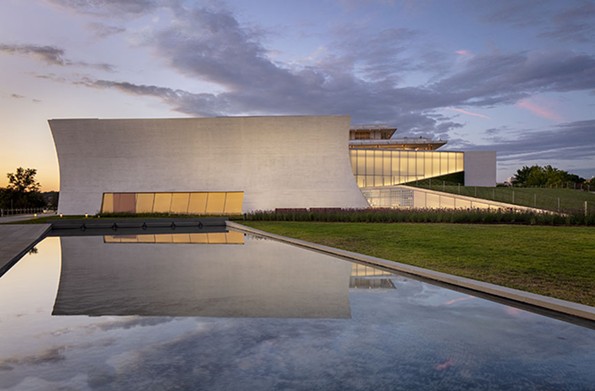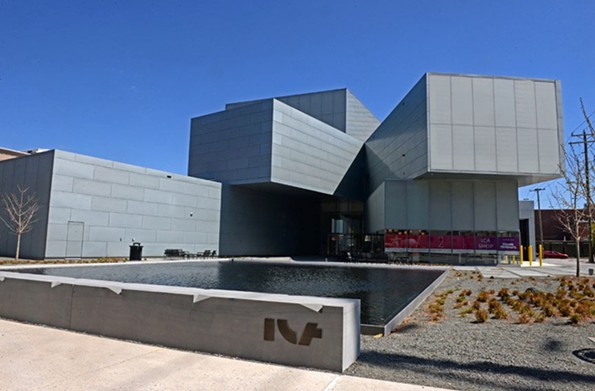By Edwin Slipek
NEW YORK and WASHINGTON — The holidays lured me to points north. I discovered that Christmas came early, both to the banks of the East River in the Hunters Point neighborhood of Queens and to the Potomac shoreline near the John F. Kennedy Center for the Performing Arts in our nation’s capital.
In September, each of these sites saw completion of a spectacular public building designed by Steven Holl Architects. The Manhattan-based firm is recognized, if not celebrated internationally, for thoughtful, poetic and place-making design solutions. The Institute for Contemporary Art at Virginia Commonwealth University that opened in spring 2018 is a case in point of how the Holl firm elegantly humanized Richmond’s frantic, vehicle-laden intersection of Broad and Belvidere streets.
The Queens branch library and the grand addition to Washington’s Kennedy Center are each highly accessible — well, almost — and praiseworthy for how they transform their respective prominent sites. Since both projects were completed in latter half of 2019, after a fraught decade of planning, design and construction, when books are written about American architecture of the 2010s, these projects will surely be documented alongside Holl’s contemporaneous Richmond project.
In addition to expanding the collection of esteemed Holl buildings along the East Coast, these two buildings offer lessons for Richmond as it continues its current building boom.
In New York, residents and city officials had long worked to create a neighborhood library in Hunters Point, a former industrial area of Long Island City that has been dramatically transformed by sleek new residential towers and a re-energized riverfront park that boasts money-shot vistas of the Manhattan skyline. The sweeping view embraces the United Nations headquarters, the Chrysler Building and the Franklin Roosevelt memorial on an East River island.
The library structure itself is a tight shoe-, no, boot-box-proportioned building that measures 22,000 square feet and rises 82 feet. Despite its tight urban setting, the $40 million structure rests so confidently in its gracefully nuanced landscape design by Michael Van Valkenburgh, that it reads as a pavilion in a well-manicured European park. Michael Kimmelman, the architecture critic of The New York Times, deemed it “a diva parading along the East River in Queens.”
The library’s white concrete, minimalist and brutalist form is broken visually by huge, whimsically shaped windows. But the openings that read as bold sculptural statements from across the river in Manhattan offer views and create architectural magic on the inside. The floor plan is a basic, tiered amphitheater with a side staircase that connects the cascade of terraces. Each tier, or level, offers various library departments — for adults, teens, children or periodicals. Each area is clearly delineated, but visually accessible from multiple points. By the time one ascends to the upper reaches of the mostly open space, the sweeping view of the interior is not only evident, but jaw-droppingly impressive.
But oops, oops and oops. Immediately after the library’s grand opening, it became clear that the building’s single elevator does not stop on every level. Therefore, wheelchair- bound or steps-averse patrons are severely limited.
A similar oversight didn’t occur with Holl’s design for Richmond’s Institute for Contemporary Art. For many decades, the university had contended with the lack of any elevator at its principal, four-story fine arts exhibition facility, the Anderson Gallery. Therefore, accessibly was a sensitive issue in the overall building design and circulation patterns flow like mountain stream water.
Currently in New York, as library officials and the architect are hustling to mitigate accessibly issues, the shelves on many of the building’s tiers have been emptied of books. Well, at least the dramatic views of Manhattan’s skyline remain spellbinding.
Some of the Hunters Point library’s architectural finesse is due to an initiative of the former city administration of Mayor Michael Bloomberg, the New York City Design Excellence Program. Learning this, it occurred to me that, in Richmond, as the Navy Hill proposal to rebuild blocks of downtown faces increasing bumps in gaining broad public acceptance, any discussion of the project has been devoid of architectural excellence or the presentation of schematic imagery that might excite people. All that Richmonders have been shown are images of generic glass boxes and fuzzy, air-brushed explosions of color suggesting where a new arena would be built. There is no match for strong, tight, imaginative images of good design, and sadly, the NH Corp. developers have not used the power of specific and strong architecture to inspire understanding and excitement.
If New York’s new library is a brilliant, visual beacon, Washington’s Reach, the aspirational name of the $250-million, 72,000-square-foot addition to the Kennedy Center, is subtle when viewed from a distance.
On the exterior of the Reach, a sweeping lawn serves double duty as a green roof. There are also reflecting pools, and importantly, the Bridge, a pedestrian walkway that connects patrons, runners, hikers and cyclists to Rock Creek Parkway. Then, there is the Video Wall Lawn, offering a riverfront venue for simulcasts and screenings. Seldom has the romantic notion of the Lawn been so wedded to the names of a public space for high tech art pieces and projections.
But don’t be fooled by the first views of the Reach. What appear to be boxy, sculpted periscopes projecting from the manicured lawns that front the Potomac on the eastern side of the monolithic Kennedy Center — its lobby is the length of two football fields — are elegant, irregularly shaped light shafts. These channel natural light into 10 major performance, rehearsal, activity and exhibition spaces below. These facilities, designed to augment the expansive programs of the nation’s largest performing arts center, are linked by a winding underground concourse that welcomes public exploration. Think of it as a well-tailored factory that celebrates, as it perfects, a range of art forms — dance, opera, theater and music.
The walls of most of these high-ceiling rehearsal spaces are lined with acoustic, custom-poured concrete blocks that were made in crinkly molds of distressed aluminum.
The walls of the long, connecting corridor are hung with large and colorful contemporary artworks on long-term loan from Glenstone, a major, privately owned art museum in nearby Potomac, Maryland. The fact that another art institution is collaborating with the federal Kennedy Center speaks to the spirit of partnership and inclusion that permeates the entire complex. The Reach is open to the public daily at no charge.
The original Kennedy Center complex was federally funded, and its Edward Durrell Stone-designed building was opened in 1971 as a memorial to the assassinated president. But construction of the Reach, like VCU’s Institute for Contemporary Art, was funded strictly by private philanthropy.
Now that the bar has been raised with this Steven Holl addition to the Kennedy Center, it’s no surprise that many observers say the original building is looking a little dated.
Similarly, in Richmond, it’s possible that as the Holl-designed contemporary art center settles in, it will continue to raise awareness for architectural excellence not just on the VCU campus, but throughout the city and region.






